Early History of Snowville by Louise B. Allison
(Transcribed by Rhonda F. Smith 9/2000)
DOWNLOAD scan of Early History of Snowville by Louise Allison PDF
This appeared in the Pulaski County Genealogy Club newsletter in October 2000
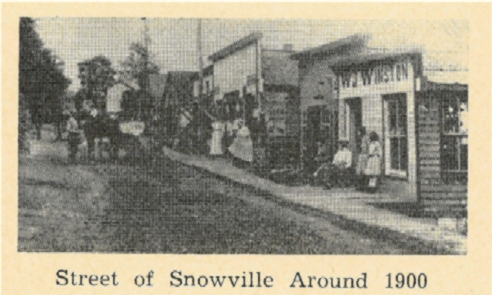
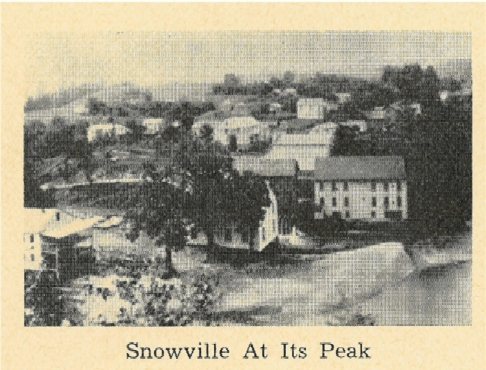
In order to obtain materials relative to the founding and early development of Snowville, a survey of the community was made. In addition, letters were written to relatives of one-time Snowville residents to secure information about its early days, its residents and industrial enterprises. Various old photographs, letters, newspaper clippings and the like were collected-not in an effort to make a complete chronicle of the life of the community, but rather to find and present a number of related pictures and incidents which would help the children in the Fourth Grade of the Snowville Elementary School to gain insights concerning the lives and incidents of their forbears. Thus, this chapter presents a series of glimpses into events, personalities, and institutions considered likely to reveal Snowville as it was in its early days.
The eldest person interviewed to get information for this phase of my work was Mr. Sam HALL of Pulaski, Virginia, who was 96 years at the time I visited him in 1958. He was the first cobbler of Snowville.
To the people who passed through Snowville in 1958, it appeared as a sleepy, all-but-deserted village; but to one disposed to delve into its past, it was a storehouse of amazing tales of better days.
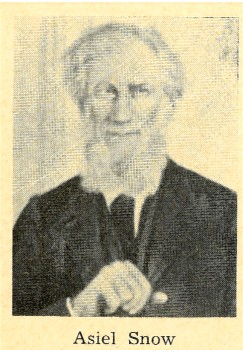
In the very early part of the nineteenth century, Asiel Snow came to Christiansburg, Virginia, from Massachusetts, and settled in order to ply his trade as a cabinet maker. Sometime after that, Johnny SIMPKINS, a young man who was then living in what later became known as Snowville, went into SNOW’s shop and ordered a cabinet.
When the piece of furniture was finished, the cabinet maker, still new to the region decided to deliver it himself-which he did. Thus, he passed right through the present sight of the little town. In doing so, he had to travel a very rough road, which was barely discernible on account of the thick growth of chinquapin bushes and other underbrush flourishing along its length.
On that journey, Snow became aware of the water power potentialities present in the Little River, and soon he began to envision a prosperous town to be located beside the river in this location.
A few years later, in 1833, he moved with his family to the place that later bore his name. However, the little town first bore two other names: It was formally designated as “The Foundry” on August 13, 1850; then “Humility”, November 18, 1850; and finally “Snowville”, March 31, 1854.
Snow was able to induce some of his Northern friends to join him in settling near his new home. Among them were the SLENKER’s, the BULLARD’s, and the BILL’s. Also from nearby southern regions came the AMEN’s, MILLER’s, PALMER’s, GODBY’s, WINSTON’s, GRAYSON’s, BISHOP’s and ABEL’s.
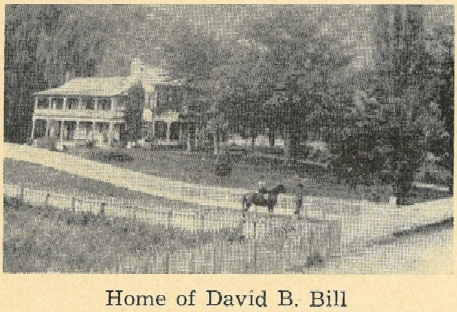
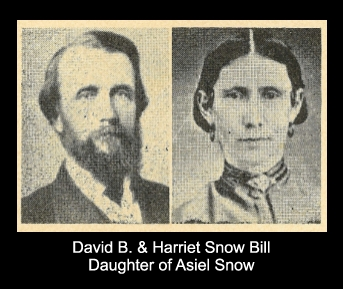
The BILL’s were promoters and merchants; the SLENKER’s, skilled textile workers; the SNOW’s, PALMER’s, GODBY’s, and WINSTON’s were carpenters and millwrights; the BULLARD’s were tanners and shoemakers. With the advent of so many skilled artisans, came the impetus to erect factories in which their respective lines might be brought into use.
Thus, a trip-hammer forge was started by Asiel SNOW and his son-in-law, David B. BILL, back where the streams called Big Laurel and Little Laurel run together some miles from the village. The cast and wrought iron products of the plant were transported to Snowville in wagons and oxen carts. From the wrought iron and other materials, skilled mechanics produced horseshoe nails, horseshoes, coulters, buck boards, buggies, jersey wagon tires, hearses; forgings for sawmills, grist mills, corn shellers, cane mills, and many other articles. The cast iron went to the foundry to be added to an ever-growing accumulation of scrap, and finally it appeared as stoves, kettles, corn shellers, cane mills, sawmills, gristmills, and hundreds of other cast-iron products.
Later, the trip-hammer forge was moved to Snowville, and a three-story building was constructed adjacent to it, each floor of which was equipped with a different kind of industry. On the first floor was an apparatus for the manufacture of linseed oil, made from the flaxseed grown in Snowville and the surrounding territory. On the second floor was machinery for sawing trees hauled from the nearby hills, thus converting them into building materials. On the third floor was a carding mill where wool was carded and made into men’s jeans and linsey dresses for women. Weeks writes that Some of the wool was put in large cotton sacks and shipped North. These bags were pinned together by thorns gathered by boys from the bushes on the hillsides. (transcriber’s note: several references are made to Earlyn WEEKS A Modern Deserted Village unpublished term paper written in connection with a course taken at Radford State Teachers College 1931)
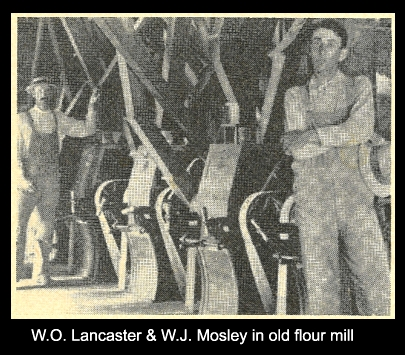
A woolen mill was started by the MESSRS. Snow and Bill and equipped with machinery which they ordered shipped from the North. However, it seems that, at the time their order was placed, the ill feeling between the North and South had become so acute that the Northern suppliers had forwarded only a little of the equipment needed to start the mill. After the close of the Civil War, a man named Isaac SLENKER finished carrying out the original plans for the large woolen mill which was to be located in a three-story building erected, in part, for that purpose. When the mill was completed, people would bring their wool, sometimes from great distances, to be converted into blankets, jeans, and even woolen carpets.
The woolen mill was instrumental in bringing about a change in the social life of the people of the village, since it brought Snowville into wider contact with the outside world; also because many of its employees were from different sections of Virginia, as well as from other states.
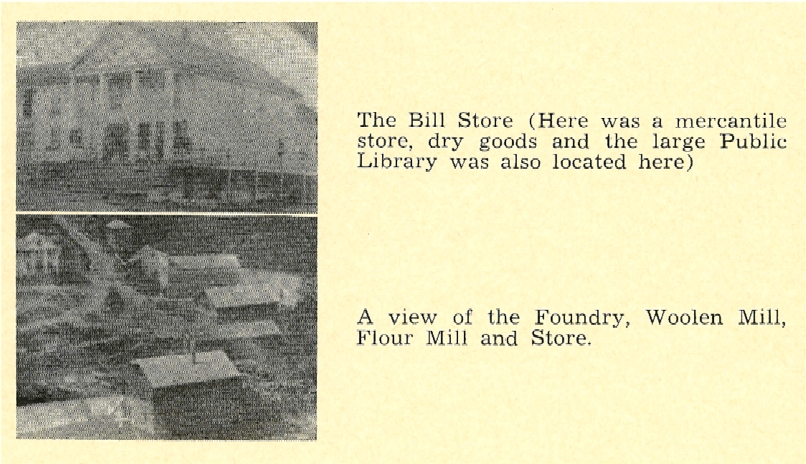
A tannery operated by W.S. BULLARD was located in the extreme west end of the village, where even to this day one may see the large pits where the leather was tanned, in the “bottom lands” alongside the Little River.
Still another enterprise was the big shoe factory which was managed by the brilliant Truman S. BULLARD. In its day, it was considered the greatest manufacturing plant of its kind in southwestern Virginia. Indeed, one might ask of any old-time Virginian: Who has not worn those good, honest boots and shoes made at Snowville? All were made in the old building which, as of the time of this writing, was known as the Red Barn.
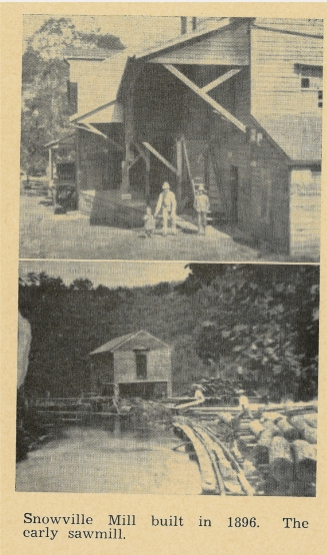
During the Civil War, a factory for making swords and bowie knives for the Confederate Army was established at Snowville, and managed by George HAMBRICK. His two sons delivered their products by oxcart to Christiansburg where they were shipped to distant markets. However, just before the surrender at Appomattox, the plant was forced to close because most of the men and boys over sixteen years of age were away fighting and thus it was left with no one to operate it.
Various carpenter shops, established from time to time, turned out household furniture of all kinds; cabinets, coffins, wooden parts of plows, wagons, buggies, tan mills, tools handles, and the like.
Joe CRAFT operated a barrel factory producing all kinds of barrels, including whiskey and flour containers; also wooden washtubs. Eggs brought to Snowville stores to exchange for merchandise were afterwards packed in barrels, in shavings or sawdust and sent to distant cities.
In still another building, feathers were cleaned and made into pillows and featherbeds.
Sam HALL was the first cobbler to serve Snowville. He moved there in April, 1898, and made his home next tot he Post Office. Later, he built a two-story building, in the upper part of which he and his family lived. He combined his trade with the management of the Post Office, on the first floor of the building.
HALL served as Postmaster from July 6, 1897, to April 4, 1914.
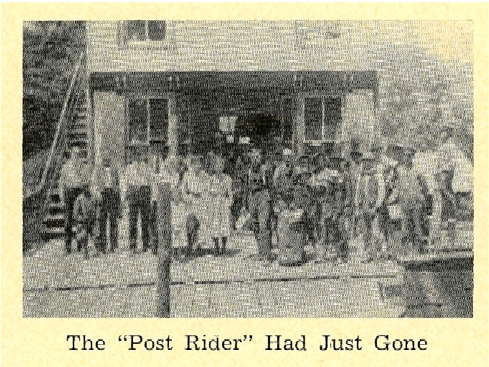
Mail was not delivered daily during the early years of Snowville, but usually came once, sometimes twice, a week. It was carried from Christiansburg by a post rider who rode a horse or mule. In the attic of the old BULLARD home, still standing in the village, there hangs a mail sack in which mail was carried thence more than a hundred years ago.
Records of the Post Office Department in Washington show that the first Post Office was established as “The Foundry” on August 13, 1850. In the same year, its name was changed to “Humility’, on November 19, 1850.
The postmasters of Humility were:
- Chester BULLARD, appointed August 13, 1850
- Reuben J. RUKE, appointed March 11, 1852
- Chester BULLARD, appointed March 25, 1854
(no explanation was found for the brevity of Chester BULLARD’s tour of duty in the position of Postmaster, which seems to have lasted only six days)
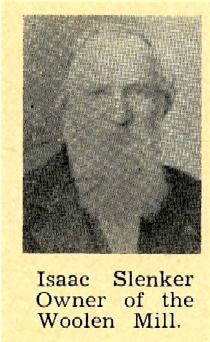
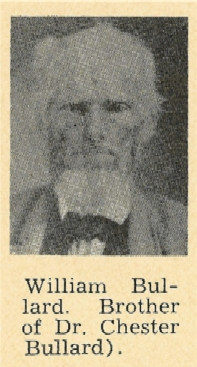

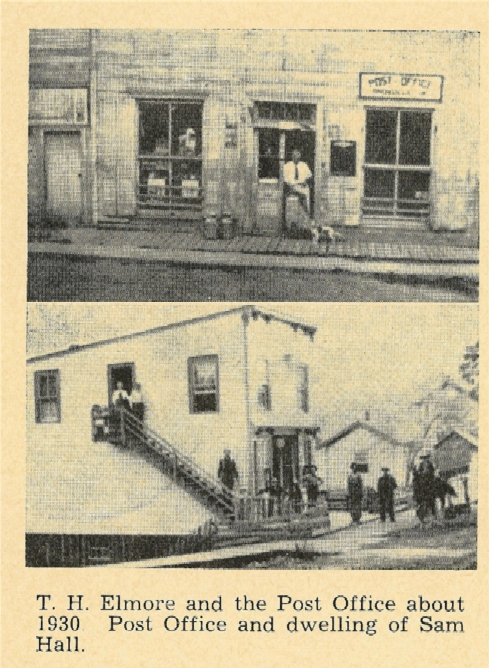
On March 31, 1854, the Snowville office was established. The following is a list of its postmasters, showing the dates on which each was appointed:
- Stillman B. SNOW, March 31, 1854
- John CARMICAL, December 31, 1857
- William T. SHELOR, November 4, 1858
- Joseph H. WINSTON, January 29, 1866
- William H. SMITH, May 27, 1872
- Joseph H. COVEY, May 3, 1881
- Joseph H. WINSTON, September 25, 1883
- James W. BOCOCK, July 20, 1885
- David J. SHOWALTER, June 10, 1889
- William SHOWALTER, October 28, 1890
- Clifton E. ELMORE, October 27, 1893
- Genetho S. HALL, July 6, 1897
- Thomas H. ELMORE, April 4. 1914
- Lonnie C. ELMORE, October 1, 1949
- Miss Martha J. BILL, May 16, 1950
The history of the religious development of Snowville seems well worth noting, since it appears that Snowville played an important part in the spreading of the denomination which is usually designated simply as the Christian Church throughout the State of Virginia and the rest of the South. Because many regarded it as the center of the movement and because it was the home of certain outstanding leaders thereof, Snowville was at one time known as the “Jerusalem of the Southwest”, it was considered by many to be the seat of what they regarded as the only true, New Testament, Christian Church.
Although, from the first, the community was composed of God fearing people, still it did not have any formal church organization nor a church edifice until, in 1870, the first institution of that nature was established under the leadership of Asiel SNOW.
The Church Building which was erected during the same year had a large balcony for the Negroes who had embraced the Christian faith. Still standing in 1958, the structure was equipped with a large bell which had been given by Miss Mary SNOW. Church records show that Miss SNOW was the first person for whom it tolled; that her death occurred shortly after she had had it installed. In the days when tolling was the practice, a death would be announced by three distinct taps of an attachment especially made for that purpose, followed by separate strokes until the age of the deceased had been indicated. (The bell was famous for its unusual toll, which could be heard as far away as Auburn, Virginia, seven miles to the east.)
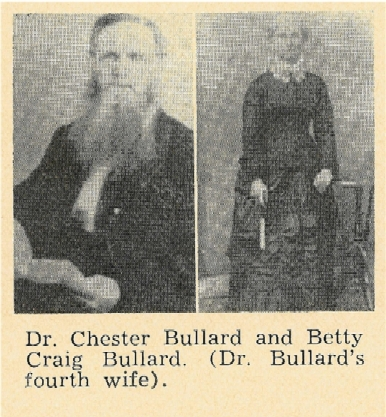
Early in the life of the Snowville church, Dr. Chester BULLARD, a relative of the Snows by marriage, came upon the scene. He was regarded by his generation as a great man, noted as a farmer, physician, and preacher of the Gospel. While practicing medicine, in and around Snowville, for many years, he also traveled widely over the country preaching according to his views of the Christian faith. It seems that Dr. BULLARD had, at one time, been a member of the Methodist Church but that he had become dissatisfied with his affiliation. Thus, he began an independent study of the New Testament, which he had determined to use as his sole guide and creed. The doctrinal positions which resulted from his labors soon began to form the basis for the ministry which he undertook at about the same time Alexander CAMPBELL and others were starting what they called the “Restoration Movement” in other parts of the country. Even though he had never heard of Campbell or his works when he began preaching, BULLARD’s beliefs were markedly similar to those of the latter. Some time after both had begun giving expression to their views, Alexander CAMPBELL heard of Dr. BULLARD, and, through correspondence, made arrangements to meet him for a religious discussion. BULLARD then rode horseback from Snowville to Charlottesville, Virginia, to their rendezvous. The two soon found that their respective interpretations of Holy Scriptures were the same. In consequence of that agreement, BULLARD joined the so-called Campbellite Movement, and became its leader in Southwestern Virginia. He is credited with having been the first to establish churches belonging to the denomination known as the Disciples of Christ in this section of the state, particularly in Snowville. He traveled far and wide, on horseback, by buggy, and even on foot, in order to preach and organize congregations at considerable distances from his home.

Dr. BULLARD was frequently described as a very able person in presenting the Gospel and as wonderfully gifted in prayer. He had a powerful voice, one which could be heard at a considerable distance. It is told that on one occasion when he was preaching at Eggleston Springs, he had his congregation gathered on the banks of a river while he crossed to the other side and preached to them from a very high cliff.
Dr. BULLARD’s early life was spent in Montgomery County, Virginia. When he was 17 years of age, he confessed Christianity but did not become active in any existing church organization. In 1831, he decided to study medicine with Dr. P.J. CHAPMAN of Giles County, Virginia. With reference to that period in BULLARD’s life, HUNDLEY says: (transcriber’s note: several references are made to “Historical Sketches of Snowville” by W.R. HUNDLEY 1931)
….amid the most picturesque and romantic scenery in the country he pursued his medical studies, earnestly desiring baptism but unable to attain it at the time, unless in the hands of a Baptist and to be united with them which he refused to do, He finally met a Mr. Landon DUNCAN who agreed to baptize him, though it was contrary to the rules of the church, and he delivered his first sermon on the day he was baptized. It was a considerable time, however, before he succeeded in making enough converts to form a church, but in 1833, the first church in Southwest Virginia organized near the Catabwa River or Creek, somewhere near the location of New Castle. His next church was organized near Snowville, Virginia, called Cypress Grove Church. Then came Allegheny in Montgomery County, next Shiloh in Pulaski County and many others followed in various parts of the country. His first son in the ministry was D.A. SNOW; next Cephus SHELBURNE; then Thomas SHELOR and many others became ministers through his influence and later on when the great meeting, or co-operation, now called Convention, were in progress in Snowville the crowd would be immense and it would often be hard to find lodging for them. Dr. BULLARD was a very hospitable man and when the services were dismissed he would go to the front door of the church and call for all the people who had no other place to go and tell them to go over on the hill to “Humility”, his home, and there they would be taken care of. On some occasions the crowd would be so large that he did not have beds for them, so he would move furniture out of the rooms and fill them with straw and tell them to go in and rest the best they could.
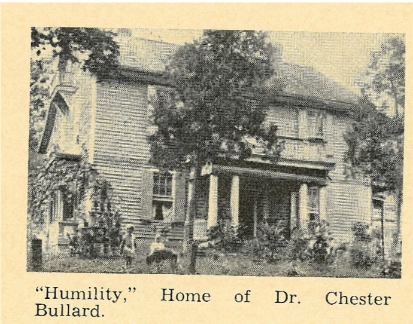
He was also a good neighbor and one year during war times he raised a large crop of potatoes on his farm. As things were so unsettled he feared these would be stolen so he put them in a secret hole under his dining room floor; then when spring came he sent out word for all of his neighbors to come and help themselves.
One of Dr. BULLARD’s peculiarities was that he preferred to put away the dead of his family without entombing them in the ground, so he obtained possession of a cave on the banks of the Little River, directly below the Snowville Cemetery, where he placed a son, two wives and a daughter. Local reports, which could not be verified, have it that the four bodies were moved to the cemetery.
Hundley related that ……once when he (BULLARD) was baptizing in a mountain stream he was annoyed by a group of boys perched on a limb over the pool who, as each convert came out of the water, would cry out “Hurrah for the Bullardites”. Finally, just as the last convert had been baptized, the limb broke and the boys fell into the stream. When the boys emerged from the water, Dr. BULLARD shouted,”Hurrah for the Devilites”.
After a long and useful ministry, he died February 27, 1893, lacking 14 days of reaching his 84th birthday. He was buried at noontime, March 1, on Chester’s Hill, a site overlooking the town of Snowville, as well as his old home, “Humility”.
Dr. BULLARD’s fourth wife was Betty CRAIG BULLARD of Newburn, Virginia. She is said to have possessed the same kind and neighborly ways as did her distinguished husband. She continued to live at Snowville after Dr. BULLARD’s death. Twelve years later, in 1905, she became ill and, after being sick only one day and night, she passed away.
In the minutes of the old Snowville Christina Church appears an entry dated January 11, 1871, as follows:
(Page 13)We, the undersigned elders and deacons of Cypress Grove Church, being convinced the wars of this world are opposed, both to the letter and spirit of the Christian religion hereby recommend to the members of above church that they do declare their determination that, under no circumstances, will they bear arms or engage in these wars.
Elders: G.W. ABELL Deacons: J.R. MILLER
J.T. SHOWALTER William GODBY
D.A. SNOW B.S. SNOW
D.A. AMMEN
From this historic old church came several prominent ministers; J.T. SHOWALTER, who came out of the War Between the States determined
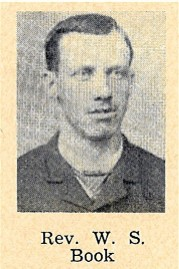
to become a minister and thereafter engaged in preaching and farming; also J.T. TAYLOR, J.D. HONAKER, W. S. BULLARD, F.F. BULLARD, W.H. BOOK, and Bernard SMITH. Most of these men were largely influenced in their work by Dr. Chester BULLARD. When F.F. BULLARD, a younger brother, was a small chap he would take a little colored boy, who belonged to Dr. BULLARD, out in the field and preach, using a stump as his pulpit, and the little Negro as his audience. Out of these experiences not one but two preachers emerged since in later years the colored boy, James MASON, also became a minister.
The religious life of the community was not without its troubles. During the first years of the War Between the States there arose a controversy between Dr. BULLARD and Cephus SHELBURNE over slavery and succession from the Federal Union-both burning issues at that time-which led to a great debate in the Snowville church. Then, some years later, there arose a sort of triangular debate between J.R. MILLER, J.T. SHOWALTER, and W.S. BULLARD, over the propriety of using organs or other musical instruments in the worship of the church. It seems that the rancor caused by those disagreements was never completely healed. When such affairs occurred they would almost ruin the peace, harmony and usefulness of the church for the time being. It was at about the time of the controversy over organ music that J.T. SHOWALTER pulled away from the Snowville church and going about two miles west of the town, founded the “New Salem” Disciples of Christ Church. In doing so, he declared that there would never be any organ or other instrumental music in the church.(author’s note: To my knowledge there has never been any use made of an instrument in that church, except one time when, for a wedding, an organ was brought from the bride’s home, used during the ceremony and removed immediately afterward.)
Arthur HAMAKER (son of Rev. John HAMAKER)
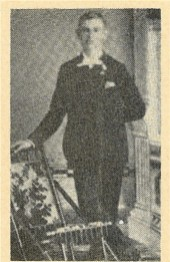
Not only was Snowville a religious center, but it was an educational center as well. Its greatest progress in education did not come until around 1856 and 1857. The first schools were private schools which were held in various homes. Then, in 1858, a public school was set up and housed in a building which had been erected originally for use as a woolen mill. When the War Between the States made it impossible to carry on the manufacturing of woolen goods, the machinery was set aside, and the building was used for the first public educational institution ever to be established in Snowville. Several years later the school vacated the erstwhile woolen mill, and moved to another structure located up on the hill back of the residential sections of the Town.
At one time, Snowville had quite a school-almost a junior college-which was supported by private subscriptions. A few leading citizens engaged Mr. John HOPWOOD to serve as a teacher in the school for a period of five years. The men who contributed their own money to promote the project were:
- William S. BULLARD, son of Dr. Chester BULLARD
- Dr. Chester BULLARD, minister
- Mr. HAYMAKER, minister
- Capt. David B. BILL, merchant
- Cliff BULLARD, grandfather of William P. BULLARD of Radford, Virginia
- Frank BULLARD, a man who later helped to found Lynchburg College
- Rush MILLER
In addition to funds supplied by these men, each pupil enrolled in a grade above the fourth paid $2.50 tuition per month.
In 1884, the Pulaski County School Board built a three-room school which was still standing at the time of this writing and was in use as a Community Club center. For a time, a building in the west end of Snowville was used to house a four- year high school and a seven-year elementary school. Later some of the high school classes were moved to the upper part of the old store building located near the Little River. For some years, students from miles around came to board at Snowville and attend school there.
At one time Messrs. E.T. and J.W. SHOWWALTER taught the four years of high school in one room. Then, about 1922, because the number of students had decreased, the offerings of the Snowville high School were reduced to two years.
Later, all high school pupils living in the Snowville area were transported to Draper, some 15 miles away, to attend school there.(author’s note: As of the time of this writing, Snowville pupils were being transported to Dublin, Virginia to attend the consolidated high school there.)
Snowville High School has graduated many boys and girls who have become successful and useful citizens. Some of them are the following:
- Dr. A.W. SHOWALTER, M.D., practicing medicine at Christiansburg, Virginia
- Bentley HITE, Attorney at Christiansburg
- Miss Clara SCOTT, Supervisor of Pulaski County
- Eddie MOSELEY, teacher of mathematics at Virginia Polytechnic Institute and a minister of the gospel.
- Manuel REYNOLDS, Principal of Riner high School
- Byron MEREDITH, Pulaski County School Board member
Numerous other business and professional people could be listed in this connection.
Among the teachers of Snowville were: Stillman B. SNOW; John HOPWOOD; Miss Annie LUCAS; Miss Grace SAYERS; E.T. and J.W. SHOWALTER; Maurice LOWMAN; Miss Marian THOMAS; Misses Marie and Helen ELMORE; Misses CARMEL, Kathryn and Ruby SHOWALTER; Miss Josephine LUCAS; and Miss Blanche LANCASTER.
Four outstanding Doctors who have served Snowville are: Dr. Bettie Snow CRUSH, Dr. J.W. STALNAKER, Dr. MARTIN and Dr. A.B. SMITH.
At one time, Snowville people engaged in many leisure-time activities. Among their amusements were coasting, skating, and dancing. Every winter, the Little River would freeze and the young people of the community would gather almost every night for several hours of skating and enjoyment. There would also be nights of coasting and dancing. The dances held then were informal square dances.
Among the facilities provided for residents of Snowville was the photography show operated by W.H. JEWEL in Snowville which he opened there about two years after the Civil War.
Around 1890, the Library Association of Snowville, of which Ed HOWERY was the head, owned and operated the largest library to be found anywhere in the section to which Snowville belonged. It was located in the Bill Store.
Charlie HERMAN printed the first Snowville newspaper in a shoe shop. The Virginia People was the name of his newspaper. When the publication was discontinued, the machinery was moved to Christiansburg where, at the time of this writing, it continued to be used for the printing of the Montgomery Messenger.
According to Dr. A.W. SHOWALTER, of Christiansburg, Virginia, the Masonic Lodge No. 159 of Snowville was chartered December 13, 1865, and is the oldest lodge in the region to which it belongs. In the Masonic Yearbook of 1954, he writes: Considering the 50 years of prosperity of Snowville, which was finally handicapped by the growth of Radford and the N & W Railroad Company during the early eighties, it is an inspiration to note that this lodge has to its credit, during all this time, nearly 93 years of continued service to the community. The spirit of “never say die” has been their motto, even when others may have thought the charter should be surrendered. Let us think in terms of the poet’s comments in thinking of Snowville No. 159.
It’s easy to fight when everything’s right, and you’re filled with the thrill and the glory; it’s easy to cheer when victory’s near, and wallow in the fields that are glory. It’s a different song when everything’s wrong, and you’re feeling infernally mortal; when it’s ten against one and hope there is none-Buck up, little soldier, and chortle.
In connection with my studies of early days in Snowville, I became acquainted with several elderly people whose recollections assisted me in forming a concept of what life was like in that community many years ago. Among them was Mrs. Frank Dean HUNT, nee Jane ABELL, who, in 1958, was nearing her 95th birthday. A former Snowville resident, she was a daughter of the late Rev. George W. ABELL, who was a pioneer minister of the Snowville Church. At the time of this writing, she was living at Mrs. Kate OWEN’s Nursing Home in Draper, Virginia.
In addition to living persons who were identified with Snowville, I learned, through various sources, about outstanding persons, no longer living, who belonged to the community. One such was Samuel Grandval PALMER, who was born May 19, 1828, at Meadows of Dan. He married Martha AMMEN in December, 1858. He served in the Confederate Army, and moved to Snowville soon after the War Between the States was over, since his new home at New Castle had been wrecked beyond repair by Federal soldiers who had torn it to pieces for firewood. In Snowville, he located his family on a homestead comprising a few acres of land with a house on it, which he had bought from David BILL, owner of the large mercantile store. PALMER was a contractor who built houses and churches. He also maintained a shop where he trained apprentices. He and his wife were members of the Christian Church, likewise each of their seven children. His oldest daughter, Kate, taught school in her father’s shop when she was sixteen years old, after the place had been provided with benches. Later she taught the very first public school to be set up at Radford, Virginia.
During my perusal of papers concerned with the old days at Snowville, I came across the following account, written by Dr. Chester BULLARD about his brother, Stillman, and published in a newspaper about 1890.
Two strokes of paralysis convinced me that I am on the borderland, I feel it my duty before my voice is hushed upon the shore to give some tragical features in the life of my brother, Stillman, in proof of the perpetuity and power of nursery impressions.

A childless couple was my father’s nearest neighbors. During my Brother Stillman’s infancy, they were, or professed to be very fond of him, which induced my parents to leave him in their care while making a visit of several days to relatives. On going to the house for the child after their return they found it deserted. No information could be obtained as to when or where they had gone. Only a parent can know the anguish of their hearts. Every effort to trace them was unavailing. One man, no doubt in collusion with them, and a fine horse, upon which my father mounted him for the pursuit, was never heard of again. For thirteen years the search was unavailing,
Most of the States were backwoods. Railroads and steamboats were not known; neither newspapers, except in the larger cities. In the meantime that child was never out of memory. Can we realize the fear of the parents for the influence of kidnappers at the best must make on his character? What a relief to know he had perished by the Indian’s tomahawk! How dreadful the return of Thanksgiving days! If for a moment he was forgotten a laugh was felt to be heartless. For thirteen years a pall hung over a family of bleeding hearts.
Ultimately a traveler, earnestly engaged to make inquisition lodged under the same roof of the boy, now seventeen years old. He was but four years old when stolen. And though so young he never did believe they were really his parents, although they had given him their name.
And this impression was confirmed when they had children of their own. If seemed at first that they were really fond of him; and he was treated somewhat as their child; but subsequently as a slave, all of which prevented what his parents most dreaded. They had no power over his heart, which, thank God, felt into the trend of his infant years.
While the stranger, who lodged under the same roof, was making inquiry for the lost child, Stillman was hurried off to bed, but not until he was convinced from what he heard that he was the child. Stealthily creeping downstairs, he gathered enough to determine him to seek a father’s house.
His captors were compelled to send him to school with their children, for they had given him their name, but the foster mother was careful to butter every piece of breading the school basket, knowing that he, from some idiosyncrasy, would be unable to eat a morsel. In the meantime he was making preparations for his advent. He procured some tools such as a saw used in the repairing of clocks and qualified himself to do honest work in this time. Indeed as time developed, he could not do any other kind of work. Gathering a very slight wardrobe, without the formalities of goodbye, he started out on his errand, supporting himself fully by the repairs he found called for in his travels.
Just as the shades of evening closed on Greenwich Plain a rustic youth called at the gabled roofed house requesting entertainment for the night. The proprietor now grown venerable bade him welcome, although a house of entertainment was near. Entering the house and being invited to take a seat, he remained standing and began to ask questions and attempting to converse. At that time, I was a white headed boy about nine years old-restless and inquisitive. I readily discovered an air of mystery in the stranger. The truth was he was laboring to prevent the sudden discovery that he was the lost child. But my childless patience could not brook delay, and I suddenly cried out, ” Mother, this is brother Stillman,” and mother asked trembling in every joint, “Are you indeed my child?” and sank faintly to the floor. My sister sank down like the swath under the mowers’ scythe, while father, brother Stillman and myself were bathed in tears. I never saw such a scene and I never shall again.
And now for the proof of the power of early impressions! The next day after the return of brother Stillman, I was sent with him to see brother William, who was employed about two miles from home. In passing through a woodland there was a patch of ground covered with checker berries. I gathered a handful, and with an overflowing heart offered them to brother Stillman. He with just such a heart, declined them. In urging his acceptance I made the impression on his mind that I professed not to be fond of them. “Oh, my dear little brother,” said Stillman, “I had rather you would tell the exact truth all the time, and in all things than to have all the berries in the world.”
Brother Stillman came out of the hands of his captors one of the most conscientious beings, not excepting my own Mother or Thomas CAMPBELL, that I have ever known. All of which must have been owing to the persistent influence of his child culture. He died very early preaching the Gospel of the Grace of god.
Another piece of writing which seemed to bear on early times in the Snowville Community is the following, written by the Rev. Dr. Goodbridge A. WILSON:
I have in my possession a manuscript that refers to two Negroes who stayed on with their masters after the war, and gives an insight into the relations between the races at that period. Mr. John GRAYSON, son of a large landowner of antebellum days, lived on the old home near the village of Graysontown in Montgomery County. After remarking that Mrs. GRAYSON was noted for many and delightful parties she would give at her home, the manuscript says Mr. GRAYSON in former days had slaves. Several of them had remained with them on the farm, among them two very heavy darkies named Harvey and Dan GUN.
Uncle Dan died very early, but Harvey lived with the GRAYSONs for many years. He was a very strong man. On one occasion while he was driving a team for them he had to deliver a load of flour in the barrel. He made a bet with someone that he could carry three barrels of flour at one time. So he placed a barrel on each hip and someone place a barrel on his head, then walked from the mill to the wagon and put all three of them on it.
Reading Goodbridge’s reference to the slaves in Snowville made it seem appropriate to make inquiries concerning the attitude of Dr. Chester BULLARD regarding slavery. Accordingly I wrote to Mrs. Elsie Bullard THOMPSON, a granddaughter of his, requesting information concerning that matter. Her reply appears as follows:
Lindside, West Virginia
April 2, 1959
Dear Mrs. Allison:
I just received your letter and in reply would say Grandpa had slaves, some of whom I knew myself-namely, “Aunt” Ann McGEE, who married the village Blacksmith, Bill McGEE. She was my father’s nurse, but very little older than he was. “Old Uncle” Billy CLARES who lived in a cabin on the far side of our place. I remember being taken out to see him. There were others but I am hazy about their names.
As to whether he approved of slavery, I don’t remember hearing, but would take it he didn’t, as he came from Massachusetts. I suppose he just followed the custom when he got down in Virginia.
I remember he always insisted on being served his meals with the colored preachers whenever they came to see him.
I hope this information will be of some help to you as little as it is. It seems to me, on further thought, he was accused of being an abolitionist about the time of the Civil War, but being a Doctor of Medicine as well as a preacher, he didn’t have to bear arms anyway.
The gallery of the Snowville Church was put in for the slaves, you know.
Grandpa had morning prayer for the slaves and kept his Bible on the shelf in the upstairs hall, which is still there (the shelf), I think.
When he had his morning service, he could be heard across the river, I’ve heard.
Best Wishes for you book,
Sincerely,
Elsie B. THOMPSON
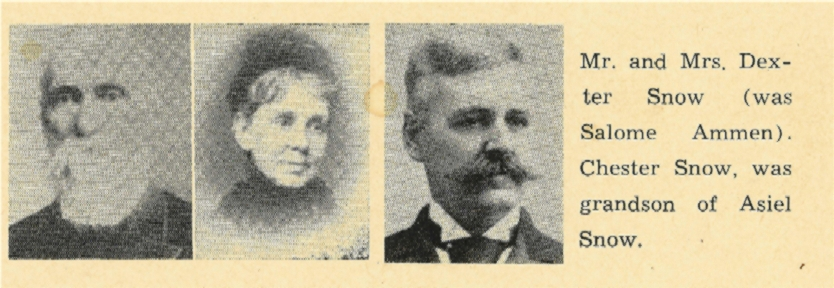
Among the various writings found during the course of my study of Snowville, few seemed to convey more vivid impressions of the life of the community that did those of W.R. HUNDLEY. The following are excerpts from a book written by him, entitled, Historical Sketch of Snowville:
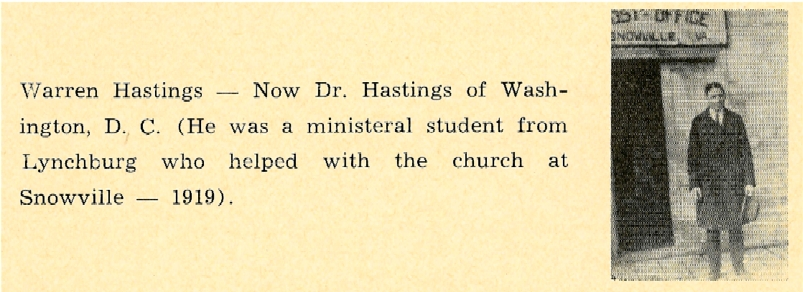
I am very proud to say that Snowville never had a bar room. While, at least, two men tried very hard to get one there, it was always voted down, but I am forced to say that there was quite a bit of “bootlegging” done, and that, mostly, done by some women of a lower type who lived adjacent to the town. The nearest thing that we had to a saloon was a grocery store where they sold Boggs Bitters and brandy peaches, which if a person drank enough of it, made him feel very rich. However, in those early days, we had three still houses where they made whiskey and brandy, tow in Pulaski County, one by Mr. Ben RIDPATH and the other by Mr. Joseph COVEY. Mr. RIDPATH’s ceased to operate about the beginning of the Civil War and the COVEY still house did not exist very long after the War. Many of the descendants from both of these families are still living in that part of the country and are very fine citizens. The third still house was in Montgomery County and was operated by Mr. Crockett MEREDITH. This one continued to operate for a long time and had quite a bad effect on the surrounding neighborhood, but as it was situated about four miles from Snowville, it did not, thus, effect our little town very much, however, this still house was within one mile of the “New Hope Church” where the Methodist people often had protractive meetings and on one occasion when old Brother SHEFFEY was preaching there, the meeting was disturbed through the still house products. Brother SHEFFEY who was known as a great believer in prayer and as this still was situated near a very large spring that came out from under an oak tree, he prayed that this tree might fall across the still house and destroy it and that much good might eventually come from the operators and patrons thereof, and sure enough during a storm lightning struck the tree and it fell across the still house and demolished it. Thus was Brother SHEFFEY’s prayer answered in this respect. It was also answered in regards to the lives of the people connected with it in as much as one son of the owner of the still house, Will MEREDITH, became a worthy minister in the Methodist Church. Another family interested in the still house was Mr. John SHELBURNE whose tow sons became members of the Christina Church and largely through their influence, a Christian Church building was erected within about one mile of the old still and was known as the “Chestnut Ridge Christian Church.” One of these men has passed on to his reward and the other still holds the small congregation together. Mr. James THOMPSON, the third interested party, had a large apple orchard which he used for making brandy and his four or five sons made fine citizens in the community, and one especially, Mr. Barney THOMPSON, who developed into a leading minister of the Methodist Church, was presiding Elder for several years and also president of Martha Washington College of Abingdon, Virginia, and is still in the service.
HUNDLEY gives an account of another miraculous incident which was not, however, related to the manufacture of distilled spirit:
I remember another unusual incident that seemed almost a miracle. On one occasion when Mr. J.T. SHOWALTER, a prominent preacher in the Christina Church, was crossing the bridge at Snowville with a two-horse wagon, a panel of the bridge’s floor gave away and the horses, wagon, driver and all fell a distance of ten or twelve feet into the water below. The fall was made in such a way that he was able to drive the wagon and the team from the river without a scratch to either the driver or the horses. Someone asked Mr. SHOWALTER if he prayed as he fell into the water and he replied, “It was no time to pray, it was time to act.”
Among HUNDLEY’s reminiscences are several anecdotes which seem to give useful insights into the life of Snowville during its early days.
I recall a very funny incident that happened one Sunday morning about church time when there was a regular bull fight in Snowville, much to the delight of us younger ones. Dr. Chester BULLARD and Mr. Reid HALL, each owned a fine male and on this morning during the preaching hour we heard Dr. BULLARD’s male begin to bellow down below the church and just before the services were dismissed we heard Mr. HALL’s male begin to bellow in the upper end of town and very soon they seemed to be answering each other and getting closer together. About the time the people came out of the church the “Gentlemen” met almost in front of the church. For fear of them some of the people went through fields to get home. They were both big, heavy animals and they came together with great force and believe me it was some fight. For tow hours or more they fought up and down the road, first one being the master, then the other. Several tried to separate them. They finally fought up the road to the gate leading to Dr. BULLARD’s farm and someone opened the gate and got them separated enough to drive the BULLARD male inside where he rushed out of sight and took the HALL male on up the road and thus ended the bull fight.
We had many incidents to divert our minds from the ordinary path of life. We had some sporting men especially two great fox hunters and each of which kept a pack of hounds for running foxes for sport. They were great for playing pranks on each other. They often dined together in their homes. Their names were William SHELOR, a son of one of our pioneer preachers and Robert TAYLOR, a moulder by trade. So TAYLOR decided to play a prank on SHELOR. He killed a fox and cut out a piece of hind leg and cooked it and asked SHELOR to dinner with him and served what he called squirrel and he ate it with considerable relish. Several days afterward TAYLOR told him what he had eaten, but SHELOR took it as a joke and told him that he would get even with him. Time passed on for a month or so, and SHELOR decided it was his turn to play a prank so he got a friend to kill him a skunk. He had apiece of it dressed and cooked and invited TAYLOR on Sunday to dine with him and served it to him as a piece of mutton. A few days afterwards, SHELOR told him what he had eaten saying, “I guess I am even with you now, TAYLOR.” TAYLOR took it all in a good humor saying, I guess skunk meat is as good as mutton so long as you think it is mutton.”
* * * *
A very exciting and interesting scene to the Snowvillians was the passing through town of a regiment of soldiers (I don’t remember the General in command) said to be about 13,000 men. They were almost one half day passing. Imagine the excitement of the people in the town.
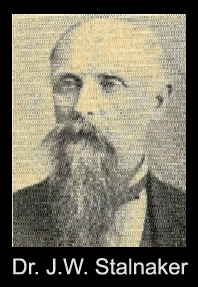
* * * *
On one occasion we had a real tragedy in Snowville and the whole town was thrown into a fit of excitement. A man came dashing into town saying that two men had been shot just up the road apiece. A good many of the town people rushed up there and found it was a true alarm. Mr. Frost PAGE and son had been having trouble with PAGE’s brother-in-law, Mr. Robert SCOTT, who lived on adjoining farms. It seemed that the PAGE’s had mistreated SCOTT for several years and he had become tired of it and he expected trouble when he started to build a line fence between their places and so on this day he took his shotgun to work with him. In the evening, Mr. PAGE, his wife and his son were going to New Salem to a school entertainment and passed by where SCOTT was at work on the fence. PAGE demanded he stop the work but he refused to do so. The PAGE boy made the remark, “I’ll stop him” and started toward SCOTT, who picked up his gun and told him to stop. The mother seeing the determination of SCOTT ran in between them. SCOTT told the mother to stand back out of the way, and pressed the trigger, fired and the boy fell, he then turned the gun on the father and shot him also. Quite a crowd soon gathered at the home where they had carried the men and there came very near being further tragedy when another son of PAGE saw SCOTT. He tried to shoot him but was hindered. It took Mr. SCOTT’s farm to clear him. He later came to Radford to live and operated a livery stable for several years. It was said that SCOTT would never let his lights go out at night. One of SCOTT’s peculiarities was that he never wore socks, even in the coldest weather.
The decline of Snowville started at the close of the War Between the States, with the establishment of the railroad which ran through Christiansburg and Radford, entirely bypassing Snowville. At that time, although a few prominent families remained in Snowville, most of the population began to rush to the city and desert the once-prosperous village.
At the time of this writing there was in Snowville a Christina Church, one general store, post office, Masonic Lodge, ad about twenty homes. Most of the breadwinners of families living there worked in Radford, or at the Radford Arsenal, situated between that city and Blacksburg; or in Christiansburg; or Pulaski. However, there still remained a few who made their living by farming in the community.
The two active organizations of the little village were, in 1958, the Snowville Community Club and the Boy Scout Troop 256 which seemed to provide social activities as well as ideas for various improvements.
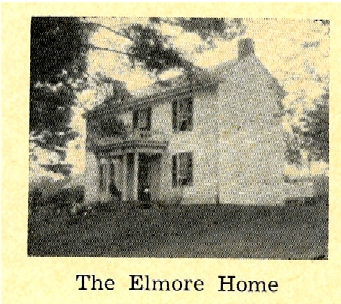
ACKNOWLEDGEMENTS
Persons to whom I am deeply grateful for the materials found herein.
- Miss Martha and Mr. David BILL Mrs. J.T. LUCAS
- Mrs. Lewis BOOTHE Mrs. Martha MCCONNELL
- Mrs. Ray COVEY Mr. Byron MEREDITH
- Mr. Frank J. CRITZER Mr. George RICHARDSON
- Mrs. Freeman CRITZER Mr. And Mrs. Roy RICHARDSON
- Mr. Lonnie ELMORE Mrs. Earlyn W. SHELBURNE
- Mr. Fay HALL Mrs. R. Leroy SHIELD
- Mr. Glenn HALL Dr. A.M. SHOWALTER
- Mr. Sam HALL (95 years old as of this writing) Mr. E.T. SHOWALTER
- Mrs. Grace HOWARD Mrs. W.F. THOMPSON
- Mr. Ray LANCASTER Mrs. R.B. WEEKS
- Dr. Goodridge WILSON

Also, My sincere thanks go to Dr. Homer HOWARD of Radford College, my graduate adviser, for his many kindnesses and untiring efforts in behalf of this undertaking.
However, the one to whom I am most obligated for aid in this work is my husband, Edward Francis ALLISON, without whose help and patience it would never have been completed.
Source : Louise B. Allison – Louise B. Allison wrote this history in 1958 and it was transcribed by Rhonda Smith
From <http://www.rootsweb.ancestry.com/~vapulask/towns/Snowville/SnowvilleHistory.html>
DOWNLOAD scan of Early History of Snowville by Louise Allison PDF

Leave a Reply